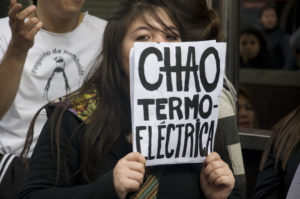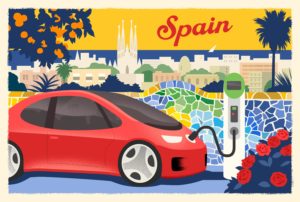Chile has set itself the goal of producing the cheapest green hydrogen on the planet and featuring among the top three exporters of the fuel two decades from now. If the plan is fulfilled, green hydrogen would make it possible to reduce the country’s greenhouse gas emissions by 25% and meet its 2050 carbon-neutrality target.
25%
of Chile's greenhouse gas emissions could be cut thanks to green hydrogen
Although hydrogen is the most abundant chemical element in the universe and was used in the first internal combustion engine, it was not considered a sustainable fuel until recently.
This is because about 95% of the hydrogen currently produced worldwide derives from oil, natural gas, and coal, earning it the name “grey hydrogen”.
But if it is produced by electrolysis – the use of electricity to separate water molecules into hydrogen and oxygen – and if that power is generated by renewable sources, hydrogen becomes a green fuel.
In recent years, solar and wind energy have advanced considerably in Chile, but are far from reaching their maximum potential. The Atacama Desert in the north of the country has the highest solar radiation in the world. Meanwhile, in the extreme south of the country there is considerable and constant wind generation. These combine to represent a renewable energy potential 70 times greater than Chile’s current electricity generation capacity – equivalent to more than 1800 GW.
For this reason, at the beginning of November Chile presented its National Green Hydrogen Strategy. Its goal is to reach 5 GW of electrolysis capacity by 2025, produce the world’s cheapest green hydrogen by 2030, and make the country one of the top three exporters of the fuel by 2040.
“Green hydrogen is a strategic opportunity for Chile. Our country is the ideal place to produce and export green hydrogen and its derivatives, including ammonia, methanol and synthetic fuels,” said energy minister Juan Carlos Jobet on presenting the strategy.
According to Chilean government estimates, the development of this industry could create close to 100,000 jobs and generate some US$200 billion in investment over the next 20 years. There could be even greater gains.
Hydrogen and Chile’s decarbonisation plan
In June 2019, President Sebastián Piñera presented a plan to decarbonise Chile’s energy matrix and make the country carbon neutral by 2050. The domestic use of green hydrogen could help reduce the country’s polluting emissions by up to 25% by the target date.
The strategy has three parts. The first will focus on large-scale domestic consumption, replacing the grey hydrogen used in the country’s refineries and introducing green hydrogen in long-distance passenger and heavy-duty transport.
Different countries are pushing green hydrogen and what we are doing today is going faster, in order to put ourselves in a good position at the global level
Stage two will be rolled out in the second half of the decade when Chile begins to export the fuel. More competitive costs of production should enable the introduction of hydrogen into new applications, such as the mining sector.
The third, longer-term phase will see sectors such as maritime and air transport decarbonised through hydrogen-derived fuels. As other countries decarbonise, export markets are expected to grow too.
Potential and barriers
Today, hydrogen is mainly used as an input in industrial processes, but a transition is gradually taking place to make it a primary energy source at the global level, says Patricio Lillo, a mining engineering professor at the Pontificia Universidad Católica de Chile.
Although there is high potential, there is still a long way to go. In addition to building the infrastructure to supply compressed hydrogen, and thus achieve scalability, there is still a price barrier. Green hydrogen is three to four times more expensive to produce than conventional hydrogen.
“The same thing happened with electric car batteries 15 years ago. By that comparison, we are standing in 2005,” says Lillo.
Lillo argues that the price reduction will not come from efficiency improvements, which will be marginal, but from a reduction in costs. Based on Chile’s renewable energy production potential, the government is betting that it will produce the cheapest green hydrogen on the planet, at less than US$1.5 per kilo.
“Different countries are pushing green hydrogen and what we are doing today is going faster, in order to put ourselves in a good position at the global level,” says Pablo Terrazas, executive vice-president of Corfo, the government agency in charge of supporting entrepreneurship, innovation, and competitiveness, and which is also involved in the hydrogen plan.
The race is already underway. Germany has committed US$10.6 to creating a local green hydrogen production industry as part of the EU’s Green New Deal. Spainwill invest a further US$10.5 billion over the next decade to produce 4 GW.
Meanwhile, China provides healthy competition for the EU that could see the costs of technology come down globally. Baofeng Energy group is building a plant in the Ningxia Hui region in the northeast of the country to produce 160 million cubic metres of green hydrogen per year.
According to the Hydrogen Council, the demand for hydrogen will increase by 40% by 2030, creating a global market for the fuel and its technologies worth around US$2.5 trillion per year.
Transforming industries
Green hydrogen will also allow Chile to clean the production process for its main export, copper, of which it is the world’s leading producer. Energy is a major input for mining and the expansion of solar and wind farms would help reduce the sector’s carbon footprint.
“The mining industry needs to transform itself in a more environmentally demanding context. In the near future we will be able to achieve a low-emission copper,” says Terrazas.
One of the bodies that will oversee this will be the new Institute of Clean Technologies (ITL), created as part of the government plan Corfo has called for a tender in 2021.
The tender has three competing proposals. The Clean Technologies Development Association (ASDIT), made up of the Antofagasta Industrialists Association (AIA), eight research centres and eleven of the country’s leading universities, proposes to install the ITL in the northern Antofagasta region, where significant mining activity takes place.
“Mining in Chile accounts for nearly 70% of the country’s contaminating emissions, so using renewable energy sources such as photovoltaic and wind power and replacing diesel with green hydrogen will save some 7 million tonnes of CO2 per year,” says Víctor Pérez, executive director of ASDIT.
Pérez adds that innovation will be key in the process of ‘greening’ mining. around. ASDIT has 200 projects in the pipeline linked to sustainable mining, energy and lithium, he says; “The technology we hope to develop will not only be transformative for the green hydrogen industry in Chile, but also for the world.”
Challenges remain. The development of human capital, since it is a new industry represents one. And the extent to which the country wants to compete in the global green hydrogen market is another.
The future Institute of Clean Technologies already has US$50 million is government backing and will bring in more private co-finance. Another US$190 million will go towards funding the other elements of the green hydrogen strategy.
“That amount is not enough to change the energy matrix for the next 50 years,” Lillo points out, but says the strategy provides a good roadmap for Chile, allowing it to figure among the 30 countries already in the race to develop green hydrogen.








